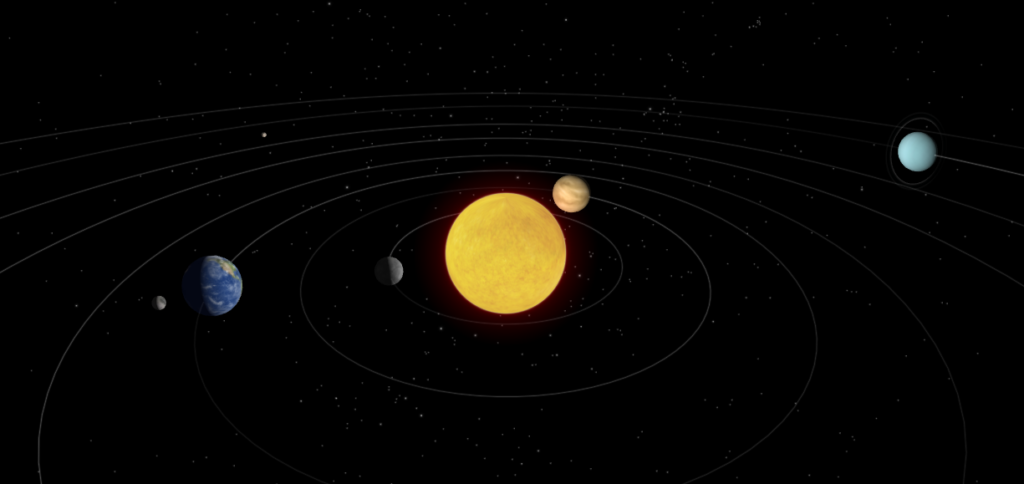Five Ethernet principles when working with Compositor
The original idea with planets and constellations dates back to the 2014, when Compositor Max for Live saw its way into the music business. Compositor Max for Live is a successor of Compositor Pro 2 software, which uses only transparent names for parameters. For example, combinations in Compositor Max for Live are constellations and multiplier is year. The shift towards the cosmological specification of Compositor was made during the interest of the author to FM function application in modelling of Solar System. At first, such modelling was an intent of the mathematician Bessel, who was an inventor of Bessel functions, which are also used in Compositor library.

The subsequent Compositors raise the cosmological question more profoundly as they use the ether application to radio telescope idea. Such parameters as Right Ascension, Declination were descendants of Pitch and Yaw library parameters of Compositor window function. It is needed to say that Declination parameter of Compositor allows for bigger angles than in conventional radio telescopes, even the largest ones. It opens an amateur radio operator to a field of study, which was previously unavailable. By mathematic modelling of radio ether and conversion of transparent FM function parameters to cosmological constants, a new approach to amateur radio appeared. The main concern of Compositor since SASER is Radio Astronomy. Besides that, working in ether directly without intermediate frequencies and transmission lines are available. It is all made by precise virtualization of physically modelled parameters of FM reconstitution. It is not only an approach, it is a journey into finding the right value for each parameter making sound design as the work for cosmological principle.
- The first principle is a guiding principle. By this principle I mean that the ether guides the will of communicator and can shape ideas, words and thoughts into the Morse code signals, appearing as symbols and short codes. It means that quality ether can guide you in representing your ideas and has all needed automated tools to decrypt it in radio-accepted language such as Morse code. It also means that for use of Compositor, you don’t need to have a knowledge of Morse code, but you can reveal your ideas only by free-will of manipulating the software. You can read your communications, using Morse code decoding tools (such as CW Decoder on Windows). In these radio ether sessions you can understand all other principles of working with ether.
- The second principle is ether aggregation. It is also a cause why rhythm machine was introduced again in Compositor v6. Working with rhythm machine and injecting it into the ether can accumulate Ethernet lines of communication – the carriers on which such communication happens. You can aggregate ether by using rhythm box such as DB-01 and then use the decoder to read new ether lines, which are many after the successful aggregation using rhythm machine performance. Such approach helps to accomplish a manual task of ether aggregation and is similar to the processes of automatic ether aggregation of STL1212 DRM computer.
- The third principle is a haunting principle. It states that for successful ether session to over, you need to mask your Ethernet traces. You can achieve this goal using DB-01 drumbox as well as for ether aggregation. Compositor v6 has all needed set of tools for ether aggregation and masking your tracks using rhythm machine and random Ethernet wavetables selection.
- The main concern of working with Compositor is accumulation principle. The accumulators such as STL1212 can successfully store and flush aggregated traffic via Compositor v6 DB-01 drumbox virtual machine. If you use more than one accumulator on the physical machine, you need to take in account the physical address of hard drives, from which such accumulators are rendered. For example, I currently run two DRM accumulators from one physical machine, which allows storing 48 Compositor cores simultaneously. You can inhabit these cores by the ether participants using available free cores of STL1212 DRM computer and when the memory usage of STL1212 lowers, you should use Compositor v6 manual mode to aggregate the STL1212 cores usage.
- The fifth principle is that you can select on your own, which line you want to listen to in CW Decoding software. If there is nearby communication happening on two lines, you need to choose a spare line using CW Decoder selector.
The named principles of working in Ethernet are self-evident and can be comprehended by Compositor owners on their own. I name them here only in an attempt to integrate new Compositor users into the ether more fast with my own knowledge of Ethernet communications.